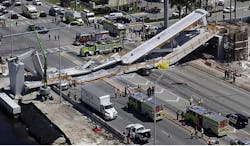New OSHA report on FIU bridge collapse finds fault with bridge designer
A new report from the U.S. Department of Labor's Occupational Safety and Health Administration (OSHA) regarding last year's collapse of the FIU pedestrian bridge in Miami places considerable blame on the bridge's designer, FIGG Bridge Engineers, for the collapse of the bridge.
The report, compiled by OSHA's Directorate of Construction, concludes that as the Engineer of Record on the project, FIGG failed to recognize that the structure was in danger of collapsing when it was inspected hours before the collapse. OSHA says the bridge should have been shored at appropriate locations and that the street beneath the structure should have been closed to traffic upon discovery that deep structural cracking was jeopardizing the bridge's integrity.
At the time of the collapse on March 15—which led to the deaths of six people—the post-tensioning bars on the structure were being re-tensioned over live traffic by FIGG's instruction, the report notes.
OSHA also says in the report that the cracks in the bridge were due to structural design deficiencies, which ultimately led to the collapse of the structure. The report also notes that though FIGG was made aware that the cracks were growing daily since first reported, the bridge designer indicated more than once they did not believe the cracks presented safety concerns.
Back in September, OSHA fined multiple contractors—including FIGG—for safety violations, determining that the companies failed to protect workers when indications of a potential bridge collapse were evident. At the time, Munilla Construction Management (MCM), the design-build contractor on the FIU bridge, also was fined. OSHA's report also calls out MCM for failing to exercise its own judgment by not closing traffic underneath the bridge until the cause of the cracks could be determined.
In November 2018, the National Transportation Safety Board (NTSB) unveiled an update on their own investigation of the collapse, which revealed that errors were made in the design of the northernmost nodal region of the 174-ft-long span, where two truss members were connected to the bridge deck.
---------
NEWS & IMAGE SOURCE: OSHA
